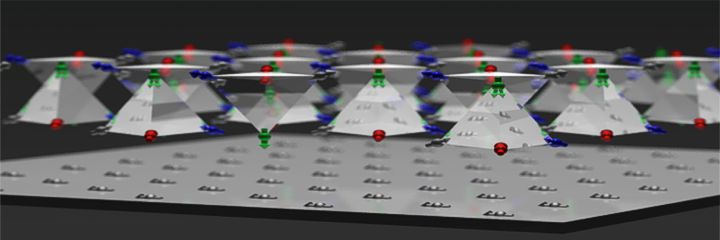Spintronics and Magnetism
The ability to manipulate the magnetic state of nanoscale ferromagnetic structures lies at the heart of information storage technologies such as hard disk drives and non-volatile magnetic random access memory (MRAM). The utilization of the electron’s spin as a logical bit promises faster information processing and energy efficiencies over charge-based devices, with potential applications in quantum computing. While the fast development of metal-based spintronics over the last two decades has transformed information storage, the realization of spin-based logic computing awaits a more complete understanding of spin-orbit and magnetic interactions in nanostructures and interfaces.
The Spintronics & Magnetism research group at the University of York combines theory, modelling and experiment to study the rich interplay between charge, orbital and spin degrees of freedom, and how it can be explored to manipulate magnetism at fundamental length and time scales. By thin film growth and advanced characterization, together with multiscale materials modelling and theory, we are able to develop a holistic approach to understand new magnetic materials and how these can be exploited for future spintronic technologies.
Work in our group spans the full range from fundamental research aimed at uncovering and understanding new physics to applied research focussed on spintronic devices.
Research topics include:
- Spin Transport and Devices
- Spin-Orbitronics in 2D Heterostructures and Dirac Hybrids
- MagnetoElectrics
- Femto-magnetism & Spinwave Dynamics
- Exchange Bias Phenomena
- Novel Magnetic Textures
- New Spintronic Materials (Inorganic and Organic)
- Magnonics
Methodologies employed and developed include:
- Magnetic Materials Growth: Sputter deposition, Metal MBE and Pulsed Laser Deposition (PLD) of complex oxides.
- Variable temperature lab based Magnetometry (VSM, FMR, MOKE, TR- MOKE)
- High-resolution transmission electron microscopy (including environmental capability)
- Advanced Synchrotron based Magnetometry (XMCD, XMLD)
- Quantum diagrammatic theory and real-space Kubo calculations
- Atomistic & Multiscale modelling
People
- Dr Gonzalo Vallejo-Fernandez – MagnetoElectrics, Spinwave Dynamics, Novel Magnetic Textures
- Dr Stuart Cavill – MagnetoElectrics, Spinwave Dynamics, Novel Magnetic Textures
- Prof Roy Chantrell – Femto-magnetism & Spinwave Dynamics
- Prof Irene D’Amico – Spin Transport
- Dr Richard Evans – Femto-magnetism & Spinwave Dynamics
- Professor Aires Ferreira – Spin Transport, Spin-Orbitronics
- Prof Sarah Thompson - Spin Transport
- Prof Atsufumi Hirohata – First-principles modelling of spintronic and magnetic materials Spin
- Dr Yvette Hancock – Transport and Devices, New Spintronic Materials (Heulser)
- Dr Jing Wu - New Spintronic Materials
- Dr Phil Hasnip – Modelling of interfaces in magnetic materials
- Dr Vlado Lazarov – Exchange Bias Phenomena
- Dr Keith McKenna – New Spintronic Materials, Organic Spintronics
- Prof Kevin O’Grady – Spin Transport
- Dr Andrew Pratt – Spin Transport
- Dr Steve Tear – Exchange Bias Phenomena

